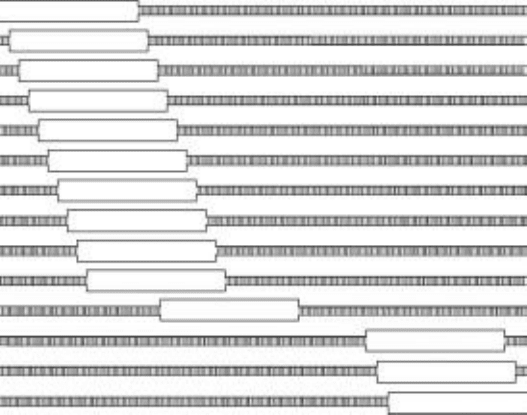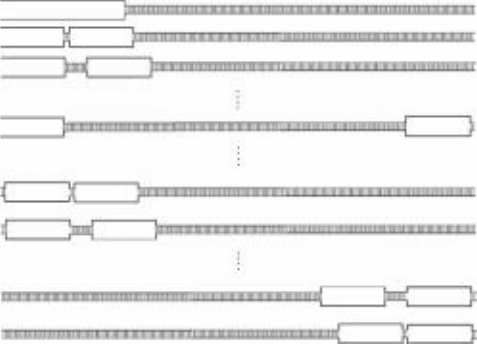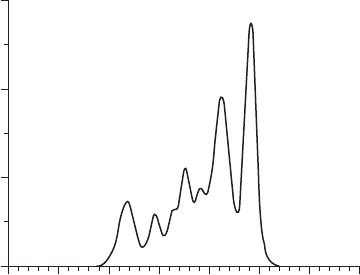Goldfarb D. Biophysics DeMYSTiFied
Подождите немного. Документ загружается.


242 Biophysics DemystifieD
The answer lies in considering the entropy change for the entire molecule.
We can explain this best by way of an example. Suppose we have a simple,
homogenous, double-helical DNA molecule 1000 base pairs long. And let’s say
this DNA molecule has enough energy to melt 300 base pairs. The question is
which contributes more to a favorable free-energy change, melting 300 bases
in a row, melting 2 segments of 150 bases each, 3 segments of 100 bases, etc.
up to 300 different segments of 1 base pair each?
We know that from an enthalpy point of view, one long segment of 300 base
pairs is favored, because each new segment requires a small amount of addi-
tional enthalpy to break the extra stacking interaction required to start a new
segment. And we know that considering the entropy contribution of each indi-
vidual base, one long segment is also favored, because again starting a new seg-
ment means melting a base with a smaller favorable entropy change compared
with melting a base next to an already melted segment. But what about the
entropy change for the overall molecule?
To keep the discussion simple, for now, we ignore the small differences in the
enthalpy change that result from having multiple melted segments, as com-
pared with melting a single segment. This difference in
H is small when we
are considering only a few segments, since it is just the addition of one more
base-stacking interaction per segment, relative to total of at least 300 stacking
interactions. Even if we consider
H resulting from melting 300 separate one-
base-pair segments, 300 additional base-stacking interactions is relatively small
compared to the large difference in S. So for now we will assume that no mat-
ter how we arrange 300 unwound bases along a 1000-base-pair molecule the
enthalpy level of the molecule is the same (only the entropy is different). With
this assumption, we can say that the different ways of arranging 300 unwound
bases along a 1000-base-pair molecule represent different ways of achieving the
same energy level, and therefore are directly related to the entropy of the mol-
ecule. The total number of ways to arrange 300 unwound bases and 700 helical
bases along a 1000-base-pair molecule is given by
W =
⋅
1000!
(300!)(700!)
(10-1)
This is approximately equal to 5.428 3 10
263
, a rather large number of ways
to achieve the same state of 300 unwound base pairs. But this large number
includes all possible distributions of the 300 unwound base pairs, from those with
a single 300-base-pair unwound segment, through those with 300 separate
unwound segments. In practice not all of these distributions of unwound bases

chapter 10 Nucleic Acid Biophysics 243
are likely to occur. Rather there will be some average cooperative unit length
somewhere between a single base pair (not cooperative at all) and 300 base pairs.
Or, in terms of the number of melted segments, somewhere between 300 melted
segments (of one base pair each) and a single segment (of 300 base pairs)
In order to consider the entropy differences for different numbers of seg-
ments, we need to calculate the number of ways of arranging the unwound
bases separately for each possible distribution of unwound segments. The math-
ematics gets a little beyond our scope, so we’ll just walk through the first few
cases to give an idea where it’s leading.
Take the case of a single segment of 300 unwound base pairs. How many ways
are there to arrange a single segment of 300 unwound base pairs in a 1000-base-
pair molecule? The answer is illustrated in Fig. 10-14. There are 701 possible
ways to arrange 300 contiguous unwound bases within a 1000-base-pair DNA.
Therefore the case of a single 300 base pair melted segment represents only 701
of the 5.428 3 10
263
total number of ways to arrange 300 melted base pairs with
any number of segments.
Now consider the case of two segments of unwound bases, each 150 base pairs in
length. This is illustrated in Fig. 10-15. Let’s count the number of ways to arrange two
FIgure 10-14 • Illustration of a 1000-base-pair DNA with 300
contiguously unwound bases. This leaves 700 base pairs still in their helical
state. The 300-base-pair segment can be at the end of the molecule or
anywhere in the middle with various numbers of the 700 helical base pairs
on either side. The illustration shows 14 of the 701 possible ways to have a
single unwound segment of 300 base pairs.

244 Biophysics DemystifieD
such segments. If we keep the left-most unwound segment at the left end of the
molecule, the other segment (of 150 unwound base pairs) can be shifted one base
pair at a time along the molecule. For this 150-base-pair segment, the situation is
identical to the case illustrated in Fig. 10-14. There are 701 ways to arrange this 150-
base-pair segment. Four of these 701 ways are shown as a, b, c, and d in Fig 10-15.
Now consider moving the left-most unwound segment just one base pair to
the right. This gives us a single helical base pair at the left end of the molecule
(see drawings e and f in Fig. 10-15). For this arrangement of the left-most seg-
ment, there are now 700 ways to arrange the other unwound segment. If we then
move the left-most segment again by one base pair, there are now only 699 ways
to arrange the other (the right-most) unwound segment. We can continue this
logic to find that the total number of ways to arrange two 150-base-pair unwound
segments along a 1000-base-pair molecule is 701 1 700 1 699 1 . . . 1 1, or
246,051. This is an amazing result! By simply dividing the 300-base-pair segment
into two, we’ve increased the number of ways to arrange the unwound base pairs
from 701 to 246,051. That’s a factor of over 350 times! This tells us that based
only on the number of ways to arrange melted base pairs, it is 350 times more
likely that the 300 based pairs will melt in two segments of 150 base pairs each
than it is that they will melt as a single segment of 300 base pairs.
Now consider three segments of 100 base pairs each. If we keep the left-
most 100-base-pair segment fixed at the left end of the molecule, the logic for
the next two segments (the middle and the right-most segment) is the same as
(a)
(b)
(c)
(d)
(e)
(f)
(g)
(h)
FIgure 10-15 • Illustration of a 1000-base-pair DNA with two
segments of 150 contiguously unwound bases each.

chapter 10 Nucleic Acid Biophysics 245
for the previous case of two segments, which gave us 246,051 ways to arrange
just those two segments. Now if we move the left-most segment just one base
pair to the right and repeat the process for the other two 100-base-pair seg-
ments, we get 700 1 699 1 . . . 1 1, or 245,350 ways to arrange the two right-
most segments. Move the left-most segment again, and we get 699 1 698 1 . . . 1 1,
or 244,650. If we continue this logic, we find that there are 57,657,951 ways
to arrange three contiguous unwound segments of 100 base pairs each.
In going from just one segment to three segments, we have increased the num-
ber of ways to arrange the unwound bases from less than a thousand to more than
57 million! You can just imagine what increasing the number of segments to 4 or
8 or 20 would do. And we have not even yet considered having different numbers
of base pairs in each of the segments. For example, take the case of two segments.
We considered 150 base pairs in each segment. What about the case of 149 base
pairs in one segment, and 151 base pairs in the other? And so on. This means that
the case of two segments does not really give us 246,051 ways to arrange the
segments, but 299 times 246,051 ways, or 73,569,249 ways. Similarly the case of
three segments was undercounted. If we include various lengths for the three
segments (e.g., instead of 100, 100, 100, consider 99, 100, 101, and 98, 100, 102,
and 98, 99, 103, etc.) the result is more than 2.5 3 10
12
ways.
still struggling
Where does the 299 come from? This is the number of ways to split 300 un-
wound base pairs into two segments. The smallest number of base pairs that can
be in a segment is one. so we start counting with a segment of 1 and a segment
of 299. From there we go to 2 and 298, followed by 3 and 297, and so on, until
we get to 299 and 1. But isn’t 1 and 299 the same as 299 and 1? The answer is yes
and no. yes they are the same if order does not matter. No, they are not the same,
if order does matter. in a homogenous sequence dNA order does not matter. so
for the case of homogenous sequence dNA we are double counting. But most
DNA sequences are heterogenous. Certainly natural DNA are, so for most DNA
we are not double counting. The important point to realize here is that splitting
the unwound base pairs up into multiple segments so greatly increases the
number of ways of arranging them along the molecule, that it doesn’t make a
significant difference whether we are double counting (the additional factor of
how to split up the base pairs among the segments) or not.
?
246 Biophysics DemystifieD
It’s easy to see from this, that unwinding more, smaller segments results in a
much larger positive entropy change than unwinding just a few or one contigu-
ous segment. So when we look at the entropy change for the whole molecule,
having more segments is more favorable to the Gibbs energy change than hav-
ing just a single segment. However, entropy considerations at the individual
base level have the opposite effect. These two opposing effects balance each
other out. The end result is that DNA unwinds in multiple segments, of some
average cooperative unit length. To summarize, there are two competing
entropy effects. They are (1) the entropy of coil state base pairs related to their
freedom of movement favoring longer contiguous unwound segments and (2)
the entropy due to the number of ways of arranging unwound bases along the
molecule. This latter entropy favors more, shorter, unwound segments. It is pos-
sible to calculate the balance between these two effects, after making some
assumptions about the enthalpy change, to arrive at a theoretical cooperative
unit length which can be compared to experimental observations.
The Assumption of the Same Energy State
Now let’s deal with the assumption that the energy of the molecule is the same
regardless of how we arrange the unwound bases. One of the ways we can deal
with this assumption is by melting fewer base pairs when we need extra enthalpy
to break the extra stacking interactions. If we do this, we are not so much remov-
ing the assumption but actually strengthening the basis for it. The technique is
this: We hold the energy of the molecule constant by melting fewer base pairs in
the case of those arrangements that would otherwise require more energy to
break the additional stacking interactions. By melting fewer base pairs we can
keep the energy constant. In this way we can assume that the energy of the mol-
ecule is constant for all of the different arrangements, with no doubts about that
assumption. If so, then all of the various arrangements (for a given energy level)
truly represent different ways of achieving the same energy state of the molecule,
and therefore truly represent the entropy state of the molecule.
So, for example, if the molecule has enough enthalpy to overcome 300 stack-
ing interactions, we can unwind 300 contiguous bases at one end of the mole-
cule. If, as another arrangement, we unwind ten separate segments (instead of
one), then we have ten additional stacking interactions to overcome. Given the
same amount of enthalpy, we can only unwind 290 base pairs. So we would
unwind 10 segments of 29 base pairs each (instead of 10 segments of 30 base
pairs each). The same argument applies as we increase the number of segments.
In the extreme case we can melt a total 150 base pairs in 150 separate segments.

chapter 10 Nucleic Acid Biophysics 247
This is because 150 separate segments (not at the ends of the molecule) require
disrupting 300 base-stacking interactions (one on each side of each segment).
In this way we can safely assume that the energy of the molecule is constant for
all of the different arrangements. The only difference between this analysis and
our previous analysis is that we are now considering a somewhat different set
of arrangements because the arrangements have different numbers of melted
base pairs. It is still very much the case, however, that as we increase the num-
ber of segments, then the number of ways of arranging them increases tremen-
dously, as we saw above.
The Helix-Coil Transition in Heterogenous DNA
Figure 10-16 shows the melting profile for a heterogenous sequence DNA. The
DNA was derived from naturally occurring DNA. There is no particular or
obvious pattern to the sequence of nucleotides. Some of the sequences are
actual genes that contain the code for building specific proteins. A portion of
the sequence is shown in Fig. 10-17. Notice that the melting profile contains
multiple peaks, in contrast to the single-peak melting profile of an homogenous
DNA in Fig. 10-9. This is indicative of the fact that different portions of the
nucleotide sequence are easier to melt than others. The portions that are easier
to melt do so at lower temperatures, whereas other portions unwind at higher
temperatures.
As we mentioned toward the beginning of this chapter, the stacking interac-
tions between various nucleotide bases are not all equal. We gave the example
Temperature (°C)
φ Cp (Kcal/degree/mol plasmid)
50
0
2000
4000
6000
55 60 65 70 75 80 85
FIgure 10-16 • Heat capacity melting profile for
pBR322 DNA.

248 Biophysics DemystifieD
that the free-energy change of stacking an adenine on top of a thymine is –0.78
kcal/mol, whereas the free-energy change from stacking adenine on top of gua-
nine is about –1.19 kcal/mol. Both are negative and so both are stabilizing
interactions, but clearly the A on top of G interaction is more stabilizing than
A on top of T. It takes more energy to disrupt an AG stack than and AT stack.
Table 10-3 lists free-energy changes for various combinations of stacked nucle-
otides. You can see clearly from the table that stacking energies that involve
guanine and cytosine are significantly higher than those that involve adenine
and thymine.
TTCTCATGTT TGACAGCTTA TCATCGATAA GCTTTAATGC GGTAGTTTAT CACAGTTAAA
TTGCTAACGC AGTCAGGCAC CGTGTATGAA ATCTAACAAT GCGCTCATCG TCATCCTCGG
CACCGTCACC CTGGATGCTG TAGGCATAGG CTTGGTTATG CCGGTACTGC CGGGCCTCTT
GCGGGATATC GTCCATTCCG ACAGCATCGC CAGTCACTAT GGCGTGCTGC TAGCGCTATA
TGCGTTGATG CAATTTCTAT GCGCACCCGT TCTCGGAGCA CTGTCCGACC GCTTTGGCCG
FIgure 10-17 • The first 300 nucleotides in the sequence for pBR322 DNA.
TABLE 10-3 Gibbs energy changes at 37 °C for
base stacking various combina-
tions of nucleotides.
Stack Energy (kcal/mol)
A/T 20.78
T/A 20.65
T/G 21.39
A/C 21.33
A/G 21.19
T/C 21.32
C/G 22.19
G/C 22.19
C/C 21.82
T/T 20.98
You can see that there is quite a variation in the Gibbs energy change required
to disrupt a stacking interaction (in order to unwind a base) depending on
which base is next to it. This means that melting of heterogeneous sequence
DNA does not necessarily begin at the ends of the molecule, nor does it begin
at more-or-less random locations along the helix. Rather, as we add energy to
chapter 10 Nucleic Acid Biophysics 249
the system, melting begins where the Gibbs energy of stacking is the smallest.
Of course, all of the considerations mentioned for homogenous DNA have to
be taken into account. This includes the enthalpy change and the entropy due
to freedom of movement for each base, as well as the entropy associated with
the number of ways of arranging the unwound bases. But we now also must
consider the variation in stacking interactions, which depend on sequence.
These variations may limit the possible arrangements of helix and coil seg-
ments. For a given energy level, not all arrangements are equally likely. Instead
the arrangements will be limited to those that involve unwinding segments
which are easier to unwind.
As we saw, the entropy associated with the number of ways to arrange
unwound bases favors having more segments with shorter cooperative unit
lengths. So limiting the number of ways to arrange the melted base pairs can
have the opposite effect, increasing the cooperative unit length and melting
fewer segments. On the other hand, the sequence itself can also have an effect
on the cooperative unit length. For example, if a section of helix contains a lot
of easily melted bases, and that section is surrounded by sequences that are
difficult to unwind, then the easy melting sequences will clearly melt first.
Under these conditions, the length of the easy melting region has a strong influ-
ence on the cooperative unit length.
The end result is that the sequence of nucleotides not only carries the genetic
code, but can have a significant influence on which regions of the double helix
are easy to unwind and which regions are difficult. This occurs both through
the strength of specific stacking interactions, as well as through their influence
on the configurational entropy of the unwound bases. This effect is important
biologically because DNA must unwind at specific locations in order to per-
form many of its biological functions, such as transcription and replication.
The Nearest-Neighbor Approximation
We can calculate the effect of sequence on unwinding DNA. Although the
calculations are beyond the scope of this book, it’s worth discussing them here
to gain an understanding of how we do it. One thing is clear; regions that
are rich in adenine and thymine melt easier than regions that are rich in guanine
and cytosine. The free energy required to disrupt a GC, GG, or CC stack can
be as much as 2 to 3 times that needed to disrupt an AT, AA, or TT stack.
Although this free energy is influenced by the sequence of bases several base
pairs away, by the number of hydrogen bonds, and by steric interactions, we can
make an approximation in our calculations. The approximation is called the

250 Biophysics DemystifieD
nearest-neighbor approximation, which means that when accounting for sequence
in a heterogenous DNA, we only consider the base stacking interactions of
bases that are immediately next to each other. The nearest-neighbor approxi-
mation gives results that agree very well with experiment; this suggests that
factors other than the nearest-neighbor stacking energies play a minimal role in
the effect of sequence on DNA melting.
The Two-State Approximation
Another approximation we can make when analyzing a melting profile for
heterogeneous DNA is to assume that each segment unwinds in an all-or-none
manner (rather than the zipper-like conformational transition we have been
describing up until now). The partition function for a two-state transition is
given by
Ze
H
RT
S
R
=+
−
∆
+
∆
1
(10-2)
This is similar to Eq. (5-16), except that the Boltzmann constant k has
been replaced by the gas constant R to reflect the convention to report ther-
modynamic values (such as the enthalpy and entropy) in units per mole of
base pairs. The other difference with Eq. (5-16) is that there is only a single
exponential term instead of the sum on the right side of the equation. This is
because we are only dealing with two states.
H and S are the enthalpy and
entropy change between state A and state B, where state A is the fully wound
helix, and state B contains the fully unwound segment of n
c
base pairs, where
n
c
is the cooperative unit length—the number of base pairs that melt together
in an all-or-none manner (thus giving rise to the appearance of a two-state
transition).
If we calculate the heat capacity melting curve from this partition function,
the result is a single bell–shaped curve similar to any one of the peaks in
Fig. 10-16. Clearly the overall melting of a heterogeneous DNA is not a two-
state transition. But the question of interest is whether each peak in the melt-
ing profile represents the melting in an all-or-none manner of a single segment.
By definition, the heat capacity is the amount of energy required to raise the
temperature of our sample by 1°. The apparent heat capacity increases (as in
Fig. 10-16) while the DNA is undergoing transition from helix to coil since
some of the energy is going into unwinding the DNA (instead of all of it going
into raising the temperature of the solution). This energy is the enthalpy of
the melting transition. If we multiply the heat capacity (kilocalories per
degree) times the range of temperature (degrees), we get the enthalpy for the

chapter 10 Nucleic Acid Biophysics 251
transition. In other words, the area under the heat capacity curve is the
enthalpy change for the melting transition. To see if each peak in the melting
profile represents a two-state transition, we fit each peak in the experimental
melting curve with a heat capacity curve calculated from the following parti-
tion function:
−+
=+
∆∆H
RT
S
R
Ze1
ω
(10-3)
Notice that this is very similar to the partition of Eq. (10-2), except for the
introduction of the variable , which is the number of identical two-state tran-
sitions occurring at the same time. For any given peak in the melting profile, if
is calculated to be equal to (or close to) 1, then
H in the exponent will be
equal to the area under the peak and we can say with confidence that the peak
represents the unwinding of a single segment that unwinds in pretty much an
all-or-none fashion. We can calculate the average enthalpy change per mole of
base pairs by taking the overall enthalpy change for melting the entire DNA
and dividing by the number of base pairs. Let’s call that
h. The ratio of the H
for one segment to the average enthalpy per base pair h gives us a measure of
the cooperative unit length n
c
. This measure of cooperative unit length however
is skewed for a heterogeneous DNA, because the average per base-pair value
h was calculated for the entire DNA molecule, whereas the peaks in the melt-
ing profile at the lower temperatures correspond to regions of the DNA that
are rich in adenine and thymine, and tend to have a smaller enthalpy change.
The peaks at higher temperatures correspond to regions of the DNA with a
higher percentage of guanine and cytosine. So n
c
calculated from an average
enthalpy for the overall DNA will tend to be underestimated for the lower
temperature peaks and overestimated for the higher temperature peaks. How-
ever, using nearest-neighbor interactions and knowing the DNA sequence, we
can calculate individual average per-base-pair enthalpies for each region of the
melting profile and, in this way, refine our estimates of the cooperative unit
length n
c
for each portion of the melting profile.
If, for a given peak in the profile, turns out to be significantly greater
than 1, then we know it is unlikely that the DNA segments in that portion of
the melting curve are unwinding in a two-state fashion. In such cases a more
gradual zipper-like model or a model that involves multiple two-state transi-
tions (unwinding of multiple segments each in an all-or-none manner) is closer
to reality. In the latter model represents the number of segments of DNA
melting in a two-state manner and n
c
would be the average length of each seg-
ment under that peak.
